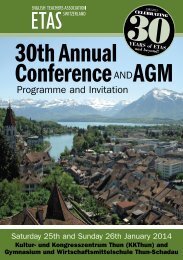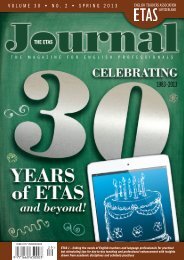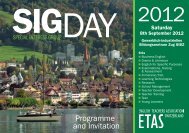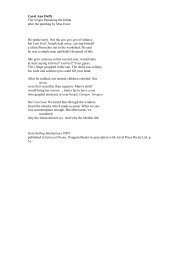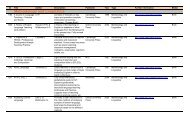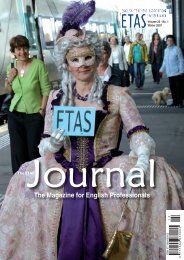Teaching English to Young Learners - English Teachers Association ...
Teaching English to Young Learners - English Teachers Association ...
Teaching English to Young Learners - English Teachers Association ...
Create successful ePaper yourself
Turn your PDF publications into a flip-book with our unique Google optimized e-Paper software.
<strong>Teaching</strong> <strong>English</strong> <strong>to</strong> <strong>Young</strong> <strong>Learners</strong><br />
FOREWORD<br />
Welcome <strong>to</strong> our Special Supplement on<br />
<strong>Teaching</strong> <strong>English</strong> <strong>to</strong> <strong>Young</strong> <strong>Learners</strong> (YLs).<br />
First and foremost, a huge ‘Thank you’<br />
<strong>to</strong> all of our contribu<strong>to</strong>rs. We have been<br />
graced with some excellent articles<br />
providing views in<strong>to</strong> YL teaching from all<br />
angles. Contributions have come from<br />
Switzerland, but also from Germany,<br />
Norway, Portugal, the UK, and Zimbabwe,<br />
adding <strong>to</strong> the culturally rich diversity of<br />
our Special Supplement on YL teaching.<br />
It has been approximately a decade since<br />
the last YL Special Supplement so it was<br />
definitely time someone did something<br />
about that. It was wonderful <strong>to</strong> work<br />
<strong>to</strong>gether on this project <strong>to</strong> give you ETAS<br />
readers a rich insight in<strong>to</strong> our colourful<br />
corner of the profession.<br />
This YL Special Supplement includes<br />
thirteen articles. There are nine articles on<br />
useful teaching resources and ideas for<br />
teaching YLs. Dorothy Sommer presents<br />
some theoretical background on how<br />
children learn, and gives suggestions on<br />
how <strong>to</strong> teach very young children and what<br />
we can do <strong>to</strong> support learning beyond the<br />
classroom. Caroline Briggs Ambrosi de<br />
Magistris Verzier discusses what makes<br />
an effective Primary <strong>English</strong> Language<br />
<strong>Teaching</strong> program. Kim Ashmore gives us<br />
a host of web links and ideas for using<br />
that up-and-coming language learning<br />
resource – the iPod <strong>to</strong>uch. An interesting<br />
contrast is Teddy Hadebe’s contribution<br />
about teaching <strong>English</strong> at Silobi Primary<br />
School in Zimbabwe and how teachers<br />
manage with limited resources. Sandie<br />
Mourão writes about using picturebooks<br />
<strong>to</strong> enhance interest and develop authentic<br />
language use while Kate Eger<strong>to</strong>n offers her<br />
suggestions for a pre-school ‘<strong>to</strong>olbox’ <strong>to</strong><br />
dip in<strong>to</strong> when teaching little ones. Mary<br />
Slattery discusses using ‘Bear’ in the YL<br />
classroom in the article called <strong>Teaching</strong><br />
with Bear: what teachers ask… . Diane<br />
Simmons-Tomczak writes about fun<br />
learning with suggestions of games and<br />
activities, and we can go singing and<br />
chanting along with Carole Nicoll and her<br />
ideas on how <strong>to</strong> help children remember<br />
useful vocabulary.<br />
A Special Supplement on teaching children<br />
would not be complete without suggestions<br />
for classroom management. Naomi Moir’s<br />
article argues that teachers cannot<br />
successfully teach <strong>English</strong> <strong>to</strong> children<br />
without good classroom management and<br />
suggests ideas on how <strong>to</strong> manage YLs,<br />
highlighting the importance of routines in<br />
teaching children successfully. Using a<br />
case study, Ruth Benvegnen illustrates how<br />
teachers can respond <strong>to</strong> challenges in the<br />
EFL YL classroom by adopting a proactive<br />
approach <strong>to</strong> problems. And lastly, Marneta<br />
Viegas stresses the importance of<br />
relaxation in the classroom and how it<br />
can help young learners focus and develop<br />
their creativity.<br />
The Supplement concludes with an article<br />
about a private extracurricular YL<br />
language school. Sarah Pralong gives<br />
an honest account of her experience of<br />
moving from teaching <strong>to</strong> running her own<br />
private YL school.<br />
We very much hope that you enjoy reading<br />
through the variety of articles in this<br />
Special Supplement and are able <strong>to</strong> extract<br />
ideas <strong>to</strong> use yourselves. By no means are<br />
all the suggestions <strong>to</strong> be confined <strong>to</strong> use<br />
with only young learners. We believe that<br />
with slight adaptation, many of these<br />
ideas are highly suitable for teaching in<br />
some of the other branches of EFL.<br />
Please feel free <strong>to</strong> give us any feedback<br />
about the Supplement and contact the<br />
contribu<strong>to</strong>rs directly if you are interested<br />
in learning more about their <strong>to</strong>pic.<br />
Ruth Benvegnen<br />
Regional Coordina<strong>to</strong>r for Lausanne<br />
Joy Cosslett<br />
YL SIG Coordina<strong>to</strong>r<br />
Am I repeating myself?<br />
Yes, I teach <strong>Young</strong> <strong>Learners</strong>!<br />
Dorothy Sommer<br />
Advantages and disadvantages of<br />
getting an early start<br />
Many parents are interested in giving their<br />
children an early start in <strong>English</strong> language<br />
learning, and here in Germany where I<br />
teach, there are even schools that offer<br />
courses for children <strong>to</strong>gether with their<br />
parents from infancy <strong>to</strong> three years of<br />
age. However, I am particularly interested<br />
in very young learners between the ages<br />
of three <strong>to</strong> five in their pre-school years.<br />
One of the main advantages of starting<br />
early is that children become accus<strong>to</strong>med<br />
<strong>to</strong> the in<strong>to</strong>nation and sounds of the new<br />
language. Moreover, for many children<br />
who do not live in a multicultural family or<br />
setting, learning about other languages<br />
and countries can be an exciting discovery.<br />
Introducing them <strong>to</strong> special festivities in<br />
the <strong>English</strong>-speaking world, in particular<br />
such holidays as Halloween or special<br />
culture-specific s<strong>to</strong>ries about Christmas,<br />
will broaden their horizons even at a<br />
tender age. Cameron (2004, p. 10) argues<br />
that “…young learners develop better<br />
pronunciation and listening skills” when<br />
they begin at an earlier age. In most<br />
cases, children do copy their teacher’s<br />
gestures and words when repeating<br />
rhymes and songs although all the while<br />
trying <strong>to</strong> understand the content.<br />
In my experience, some of the problems<br />
and disadvantages come later when<br />
children start <strong>English</strong> in school and have<br />
<strong>to</strong> re-learn the same <strong>to</strong>pics that were<br />
already at the core of their early learning<br />
lessons. For example, a child who has<br />
been introduced <strong>to</strong> colors, food, and farm<br />
animals for two years no longer needs <strong>to</strong><br />
start from scratch in school. Unfortunately,<br />
there is often very little room for this kind<br />
of flexibility in the curriculum. Cameron<br />
(2004) mentions that this and the overall<br />
duration of <strong>English</strong> learning might cause<br />
problems in sustaining motivation over a<br />
long period of time.<br />
Nevertheless, children are not just learning<br />
a second language, or about foreign<br />
holidays, but also more about the world<br />
around them through <strong>English</strong>. Carol Read<br />
(2003, p. 6) also notes that younger<br />
learners are not only more flexible and<br />
can easily be motivated, but are also at<br />
a point in their development that could be<br />
beneficial for language learning.<br />
How children learn<br />
Nonetheless, every child has a tremendous<br />
potential for learning. Psychologists Wood,<br />
Bruner, and Ross (1976) introduced the<br />
term “scaffolding” <strong>to</strong> describe the tu<strong>to</strong>rial<br />
interaction between an adult and a child.<br />
The term was used <strong>to</strong> explore the nature<br />
of the support system provided by a<br />
ETAS Journal 28/3 Summer 2011 31



